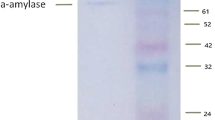Abstract
Properties of the extracellular amylase produced by the psychrotrophic bacterium, Arthrobacter psychrolactophilus, were determined for crude preparations and purified enzyme. The hydrolysis of soluble starch by concentrated crude preparations was found to be a nonlinear function of time at 30 and 40 °C. Concentrates of supernatant fractions incubated without substrate exhibited poor stability at 30, 40, or 50 °C, with 87% inactivation after 21 h at 30 °C, 45% inactivation after 40 min at 40 °C and 90% inactivation after 10 min at 50 °C. Proteases known to be present in crude preparations had a temperature optimum of 50 °C, but accounted for a small fraction of thermal instability. Inactivation at 30, 40, or 50 °C was not slowed by adding 20 mg/ml bovine serum albumin or protease inhibitor cocktail to the preparations or the assays to protect against proteases. Purified amylase preparations were almost as thermally sensitive in the absence of substrate as crude preparations. The temperature optimum of the amylase in short incubations with Sigma Infinity Amylase Reagent was about 50 °C, and the amylase required Ca+2 for activity. The optimal pH for activity was 5.0–9.0 on soluble starch (30 °C), and the amylase exhibited a K m with 4-nitrophenyl-α-D-maltoheptaoside-4,6-O-ethylidene of 120 μM at 22 °C. The amylase in crude concentrates initially hydrolyzed raw starch at 30 °C at about the same rate as an equal number of units of barley α-amylase, but lost most of its activity after only a few hours.








Similar content being viewed by others
References
Aghajari N, Feller G, Gerday C, Haser R (1998) Structures of the psychrophilic Alteromonas haloplanctis α-amylase give insights into cold adaptation at a molecular level. Structure 6:1503–1516
Barnes WA, Blakeney A (1974) Determination of cereal alpha amylase using a commercially available dye-labelled substrate. Die Starke 26:193–197
Bradford M (1976) A rapid and sensitive method for the quantitation of microgram quantities of protein using the principle of protein-dye binding. Anal Biochem 72:248–254
Caviocchioli R, Siddiqur K, Andrews D, Sowers K (2002) Low temperature extremophiles and their applications. Curr Opin Biotechnol 13:253–261
Chessa J, Feller G, Gerday C (1999) Purification and characterization of the heat-labile α-amylase secreted by the psychrophilic bacterium TAC 240B. Can J Microbiol 45:452–457
Amico SD, Marx J, Gerday C, Feller G (2003) Activity-stability relationships in extremophilic enzymes. J Biol Chem 278:7891–7896
Feller G (2003) Molecular adaptations of cold in psychrophilic enzymes. Cell Mol Life Sci 60:648–662
Feller G, Gerday P (1997) Psychrophilic enzymes: molecular basis of cold adaptation. CMLS Cell Mol Life Sci 53:830–841
Feller G, Narinx E, Arpigny J, Aittaleb M, Baise E, Genicot S, Gerday C (1996) Enzymes from psychrophilic organisms. FEMS Microbiol Rev 18:189–202
Feller G, Lonhiene T, Deroanne C, Libioulle C, Beeumen J, Gerday C (1992) Purification, characterization, and nucleotide sequence of the thermolabile α-amylase from the antarctic psychrotroph Alteromonas haloplanctis A23. J Biol Chem 267:5217–5221
Feller G, Payan F, Theys F, Quian M, Haser R, Gerday C (1994) Stability and structural analysis of α-amylase from the antarctic psychrophile Alteromonas haloplanctis A23. Eur J Biochem 222:441–447
Georlette D, Blaise V, Collins T, Amico SD, Gratia E, Hoyoux A, Marx J, Sonan G, Feller G, Gerday C (2004) Some like it cold: biocatalysis at low temperatures. FEMS Microbiol Rev 28:24–42
Girard C, Michaud D (2002) Direct monitoring of extracellular protease activities in microbial cultures. Anal Biochem 308:388–391
Kazuoka T, Masuda Y, Oikawa T, Soda K (2003) Thermostable aspartase from a marine psychrophile, Cytophaga sp. KUC-1: molecular characterization and primary structure. J Biochem 133:51–58
Loveland J, Gutsall K, Kasmir J, Prema P, Brenchley J (1994) Characterization of psychrotrophic microorganisms producing β-galactosidase activities. Appl Environ Microbiol 60:12–18
Loveland-Curtze J, Sheridan P, Gutshell K, Brenchley J (1999) Biochemical and phylogenetic analyses of psychrophilic isolates belonging to the Arthrobacter subgroup and description of Arthrobacter psychrolactophilus, sp. nov. Arch Microbiol 171:355–363
Morita R (1975) Psychrophilic bacteria. Bacteriol Rev 39:144–167
Miyazaki K, Wintrode P, Grayling R, Rubingh D, Arnold F (2000) Directed evolution study of temperature adaptation in a psychrophilic enzyme. J Mol Biol 297:1015–1026
Nigam P, Singh D (1995) Enzyme and microbial systems involved in starch processing. Enz Microb Technol 17:770–778
Pandey A, Nigam P, Soccol C, Soccol V, Singh D, Mohan R (2000) Advances in microbial amylases. Biotechnol Appl Biochem 31:135–152
Russel N (1998) Molecular adaptations in psychrophilic bacteria: potential for biotechnological applications. Adv Biochem Eng Biotechnol 61:1–21
Russell N (2000) Toward a molecular understanding of cold activity of enzymes from psychrophiles. Extremophiles 4:83–90
Sarath G, de la Motte R, Wagner F (1989) Protease assay methods. In: Beynon RJ, Bond JS (eds) Proteolytic enzymes a practical approach. IRL Press, Oxford, p 28
Smith M, Zahnley J (2005) Production of amylase by Arthrobacter psychrolactophilus. J Ind Microbiol Biotechnol 32:279–283
Sumner J, Howell S (1935) A method for the determination of saccharase activity. J Biol Chem 108:51–54
Textor S, Hill A, MacDonald D, St Denis E (1998) Cold enzyme hydrolysis of wheat starch granules. Can J Chem Eng 76:87–93
Trimbur D, Gutshall K, Prema P, Brenchley J (1994) Characterization of a psychrotrophic Arthrobacter gene and its cold-active β-galactosidase. Appl Environ Microbiol 60:4544–4552
Vihinen M, Mantsala P (1989) Microbial amylolytic enzymes. CRC Crit Rev Biochem Mol Biol 24:329–418
Author information
Authors and Affiliations
Corresponding author
Rights and permissions
About this article
Cite this article
Smith, M.R., Zahnley, J.C. Characteristics of the amylase of Arthrobacter psychrolactophilus . J IND MICROBIOL BIOTECHNOL 32, 439–448 (2005). https://doi.org/10.1007/s10295-005-0015-x
Received:
Accepted:
Published:
Issue Date:
DOI: https://doi.org/10.1007/s10295-005-0015-x




